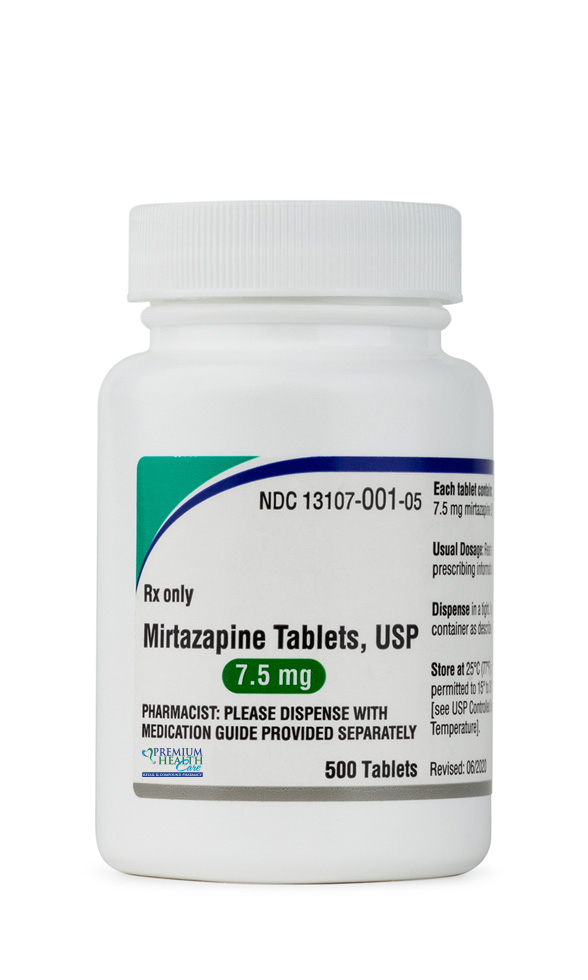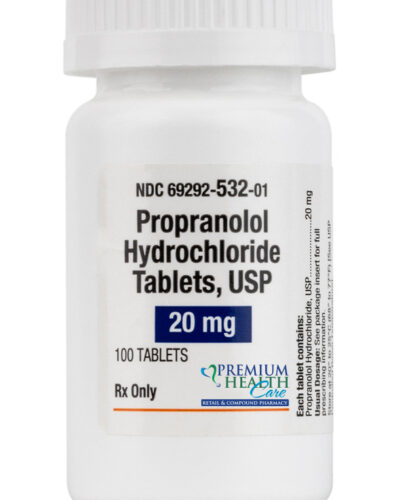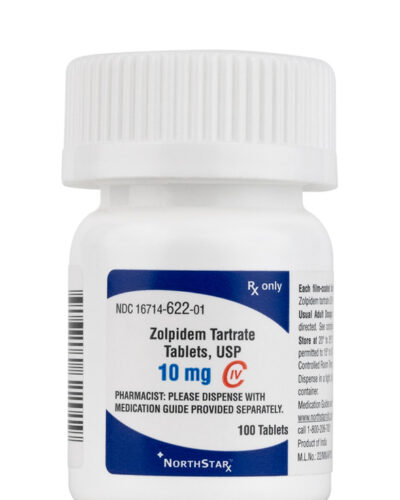Description
About Mirtazapine Tablets
Mirtazapine is an atypical antidepressant which may assist with major depressive disorder (MDD). Its unique mechanism works to potentially enhance brain activity, which may help to improve mood, appetite, and sleep patterns. Mirtazapine may also have sedative properties, which may be beneficial for individuals experiencing insomnia associated with depression.[1]
Mechanisms of Action
Mirtazapine may inhibit central presynaptic alpha-2 adrenergic receptors, which may increase the release of norepinephrine and serotonin. It may also selectively antagonize several serotonin receptors, including 5-HT2A, 5-HT2C and 5-HT3 receptors. This selective antagonism may allow remaining serotonin to interact more freely with 5-HT1 receptors, particularly 5-HT1A, which may potentially contribute to its antidepressant effects. Additionally, mirtazapine may exhibit potent antagonism of histamine H1 receptors, which may produce sedative effects.[1]
Contraindications & Precautions
Contraindications
Mirtazapine has a black box warning due to its potential to paradoxically worsen depression and anxiety in some individuals, and in some cases, it may potentially increase the risk of suicidal thoughts.[1]
Mirtazapine is contraindicated in patients currently taking monoamine oxidase inhibitors (MAOIs) or those who have used them in the past 14 days due to the risk of serious and potentially fatal interactions, including serotonin syndrome. This precaution may extend to other medications that may also potentially increase serotonin levels, such as methylene blue or linezolid.[1][2]
Precautions
Agranulocytosis:
Cases of severe neutropenia and agranulocytosis have been reported.[3]
Hepatic and Renal Impairment:
Use with caution in patients with hepatic or renal impairment, as these conditions may affect drug clearance.[1]
Seizure Risk:
Caution is advised for those with a history of seizures due to potential risk.[4]
Metabolic Effects:
Mirtazapine, like other antidepressants, has been associated with weight gain and metabolic issues, which may lead to treatment discontinuation despite its potential benefits. These changes may potentially impact glycemic control and lipid levels, though evidence on overall metabolic function is inconsistent. Additionally, depression may also increase the risk of obesity and metabolic disorders, which may complicate patient care. Factors such as dietary changes, reduced physical activity, and hormonal imbalances during depression may potentially contribute to weight gain independently of medication use. Careful monitoring of weight and metabolic health is recommended for patients on mirtazapine, particularly those with pre-existing metabolic concerns.[5]
Orthostatic Hypotension:
Mirtazapine typically has minimal effects on blood pressure but may potentially cause orthostatic hypotension, potentially leading to dizziness and falls. This risk is particularly relevant in individuals with cardiovascular conditions. Careful monitoring of blood pressure is recommended when starting or adjusting mirtazapine, especially in elderly patients or those with pre-existing risk factors for falls.[6]
Anticholinergic Effects:
Mirtazapine may exhibit low anticholinergic activity; however, it may still cause side effects such as constipation. This potential effect may stem from its adrenergic actions rather than cholinergic pathways.[7]
Geriatric Considerations:
Studies have not identified specific geriatric problems that would limit the use of mirtazapine in elderly patients. However, older adults may be more prone to confusion, unusual drowsiness, and age-related liver, kidney, or heart issues, which may necessitate caution and dosage adjustments when prescribing mirtazapine to this population.[8]
NOTE: This list may not include all possible contraindications and precautions.
Interaction
Mirtazapine may interact with various medications, potentially leading to enhanced effects or increased risk. Possible sedative effects of mirtazapine may be intensified when combined with other sedative drugs. Potential interactions may include benzodiazepines like diazepam, pain medications such as tramadol, and drugs that may affect serotonin levels. Antacids (e.g., cimetidine), antifungals (e.g., ketoconazole), and herbal supplements like St. John’s Wort and tryptophan may also potentially interact with mirtazapine. Caution is warranted when combining mirtazapine with seizure medications (e.g., phenytoin, carbamazepine), migraine medications (e.g., sumatriptan, zolmitriptan), and medications commonly prescribed for mood and thought disorders (e.g., lithium, other antidepressants, and antipsychotics).[1]
NOTE: This is not a comprehensive list of medications that may interact with mirtazapine. For a complete understanding of potential interactions, please consult a healthcare professional or specialized resource.
Adverse Reactions / Side Effects
Common Adverse Effects
Common side effects of mirtazapine may include drowsiness and sedation. Users may also experience an increase in appetite, which may potentially lead to weight gain. Additionally, mirtazapine may cause dry mouth, constipation, and potentially affect serum cholesterol levels, with a potential association with hypertriglyceridemia.[1]
Less Common Adverse Effects
While less frequent, mirtazapine may be associated with a range of other side effects. Some individuals may experience dizziness, tremors, or abnormal dreams.[9][10]
Mirtazapine has also been linked to some serious but uncommon blood-related side effects. These may include thrombocytopenia, bone marrow suppression, and neutropenia, which may impact blood cell counts. Cardiovascular concerns may arise, particularly in patients with pre-existing heart conditions. Caution is advised when using this medication alongside other blood pressure medications like clonidine, as it may potentially antagonize its hypotensive effects.[1]
Some individuals may experience transient changes in liver function tests, and in some cases, acute liver injury has been reported.[11] Another uncommon but serious potential side effect is acute pancreatitis, which may be life-threatening.[12]
It is important to note that abrupt discontinuation of mirtazapine may lead to discontinuation syndrome. Symptoms of discontinuation syndrome may include dizziness, abnormal dreams, and sensory disturbances. To minimize this risk, a gradual tapering of the medication under medical supervision is typically recommended.[1][13]
Pregnancy & Breastfeeding
There is no consistent evidence of a specific malformation pattern associated with antidepressant use during pregnancy. However, studies suggest that postnatal adaptation syndrome (PNAS) may occur in up to 30% of neonates exposed to antidepressants in late pregnancy. Given this consideration, healthcare providers often recommend individualized assessments, weighing the risks of untreated maternal depression against potential medical effects, and close monitoring of exposed neonates.[14]
NOTE: If treatment with mirtazapine is necessary during pregnancy, a thorough discussion of the potential risks and benefits should be conducted with a healthcare provider.
Based on available research, mirtazapine may be compatible with breastfeeding when used at therapeutic doses. Studies suggest that the drug passes into breast milk in low amounts, potentially resulting in minimal infant exposure. Mothers taking mirtazapine may be able to breastfeed, especially if their infants are over 2 months old. However, healthcare providers may recommend monitoring breastfed infants for potential behavioral changes or growth effects. While limited data indicates no significant adverse effects in breastfed infants, individual cases may vary.[15]
NOTE: If treatment with mirtazapine is necessary during breastfeeding, a thorough discussion of the potential risks and benefits should be conducted with a healthcare provider.
Storage
Store this medication at 68°F to 77°F (20°C – 25°C) and away from heat, moisture and light. Keep all medicine out of the reach of children. Throw away any unused medicine after the beyond use date. Do not flush unused medications or pour down a sink or drain.
References
- Jilani TN, Gibbons JR, Faizy RM, et al. Mirtazapine. [Updated 2023 Aug 28]. In: StatPearls [Internet]. Treasure Island (FL): StatPearls Publishing; 2024 Jan-. Available from: https://www.ncbi.nlm.nih.gov/books/NBK519059/– LinkOpens in New Tab
- Buckley NA, McManus PR. Fatal toxicity of serotoninergic and other antidepressant drugs: analysis of United Kingdom mortality data. BMJ. 2002 Dec 7;325(7376):1332-3. doi: 10.1136/bmj.325.7376.1332.
- Toprak, Selami K, et al. “Mirtazapine-Induced Thrombocytopenia and Neutropenia.” Turkish Journal of Hematology, vol. 29, no. 3, 2012, pp. 297–298, https://doi.org/10.5505/tjh.2012.72325.– LinkOpens in New Tab
- Teo, L. “P-1116 – Seizures Associated with Mirtazapine: A Case Report and Review of Literature.” European Psychiatry, vol. 27, Jan. 2012, p. 1, https://doi.org/10.1016/s0924-9338(12)75283-5.– LinkOpens in New Tab Accessed 3 May 2019.
- Hennings, Johannes M., et al. “Effect of Mirtazapine on Metabolism and Energy Substrate Partitioning in Healthy Men.” JCI Insight, vol. 4, no. 1, 10 Jan. 2019, pubmed.ncbi.nlm.nih.gov/30626746/, https://doi.org/10.1172/jci.insight.123786.– LinkOpens in New Tab
- Calvi A, Fischetti I, Verzicco I, Belvederi Murri M, Zanetidou S, Volpi R, Coghi P, Tedeschi S, Amore M, Cabassi A. Antidepressant Drugs Effects on Blood Pressure. Front Cardiovasc Med. 2021 Aug 3;8:704281. doi: 10.3389/fcvm.2021.704281.
- Bishara D. Anticholinergic action is rarely a good thing. Therapeutic Advances in Psychopharmacology. 2023;13. doi:10.1177/20451253231195264
- “Mirtazapine (Oral Route) before Using – Mayo Clinic.” Www.mayoclinic.org, www.mayoclinic.org/drugs-supplements/mirtazapine-oral-route/before-using/drg-20067334.
- Davis, R., Wilde, M.I. Mirtazapine. CNS Drugs 5, 389–402 (1996). https://doi.org/10.2165/00023210-199605050-00007– LinkOpens in New Tab
- Mathews M, Basil B, Evcimen H, Adetunji B, Joseph S. Mirtazapine-induced nightmares. Prim Care Companion J Clin Psychiatry. 2006;8(5):311. doi: 10.4088/pcc.v08n0510b.
- LiverTox: Clinical and Research Information on Drug-Induced Liver Injury [Internet]. Bethesda (MD): National Institute of Diabetes and Digestive and Kidney Diseases; 2012-. Mirtazapine. [Updated 2020 Feb 26]. Available from: https://www.ncbi.nlm.nih.gov/books/NBK548216/– LinkOpens in New Tab
- Bowers RD, Valanejad SM, Holombo AA. Mirtazapine-Induced Pancreatitis—A Case Report. Journal of Pharmacy Practice. 2019;32(5):586-588. doi:10.1177/0897190018760645
- Gabriel M, Sharma V. Antidepressant discontinuation syndrome. CMAJ. 2017 May 29;189(21):E747. doi: 10.1503/cmaj.160991.
- Byatt N, Deligiannidis KM, Freeman MP. Antidepressant use in pregnancy: a critical review focused on risks and controversies. Acta Psychiatr Scand. 2013 Feb;127(2):94-114. doi: 10.1111/acps.12042. Epub 2012 Dec 14.
- Drugs and Lactation Database (LactMed®) [Internet]. Bethesda (MD): National Institute of Child Health and Human Development; 2006-. Mirtazapine. [Updated 2024 Jan 15]. Available from: https://www.ncbi.nlm.nih.gov/books/NBK501188/– LinkOpens in New Tab
- “Mirtazapine (Oral Route) Proper Use – Mayo Clinic.” Www.mayoclinic.org, www.mayoclinic.org/drugs-supplements/mirtazapine-oral-route/proper-use/drg-20067334.






Reviews
There are no reviews yet.